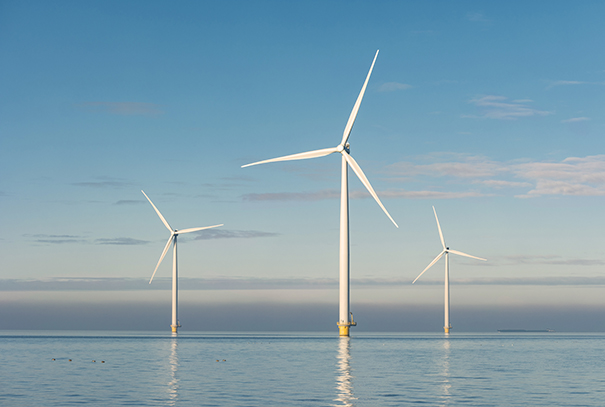
The number of countries committing to future targets of a net zero carbon economy is ever increasing and renewable energy will need to become a pillar of our energy systems in order to achieve this. Offshore wind will be a vital component of this transition and in our latest energy update, we delve into upcoming opportunities and challenges within the offshore wind sector of renewables.
According to the Global Wind Energy Council, 2020 broke all previous annual records for the largest installation of wind capacity. Considering the disruption to the global supply chain due to COVID-19, this is a great achievement for the industry. In total 93GW of wind capacity was installed last year. In offshore wind 6.1GW was installed, which is the second best year on record. Half of this capacity was installed offshore China with other notable regions including Europe, US and South Korea. The total offshore wind capacity is now greater than 35GW, which is 4.8% of total global wind capacity. According to GWEC Market Intelligence, the expectation is that more than 70 GW of offshore wind capacity of installation will take place worldwide in 2021 to 20251.
The growth in the offshore wind industry presents new opportunities as well as new challenges for the insurance industry. Not only will it just be oil and gas companies that need to adjust in order to play their role in the transition to greener energy, but insurance companies will have to adjust as well. This trend has already started to take fruition, with traditionally offshore oil and gas markets now looking to support the large offshore wind development projects.
In spite of this, the insurance market is challenging the approaches to traditional forms of cover and terms which they have usually provided to their clients. There is a global hardening in the offshore wind market after continued loss-making years. Underwriters are now under pressure to restrict coverage, load rates and increase deductibles in an attempt to bring some profitability to their books.
The principle exposure areas for underwriters in offshore wind have included the cable networks (inter-array and export), where there has been a high prevalence of losses due to design and installation issues. Serial defects in the foundations, cable connections or turbines have also caused losses; as well as the lack of experience and the track-record of contractors. Furthermore, incidents at the offshore and onshore substations have resulted in large delay or interruption losses; often caused by windstorms or fires, which can have huge financial implications for insurers as these are both full revenue exposures.
In order to counteract the impacts of these losses, underwriters are trying to restrict coverage and amend traditional wordings where possible. Traditional wordings used for offshore wind projects are WindCAR and WindOp. These wordings have typically provided series loss and defects coverage, which we have now seen being limited by the insurance market. Despite the diminishing availability of these policies, the market has offered some viable solutions. Clients should look to use Marine Warranty Surveyors (MWS) as a form of protection in a hardening market as positive survey results can give the insurers a sense of comfort to keep providing their clients with the same type of coverage.
The technological improvements in the design of offshore wind turbines means that they can generate far more wind power than ever before. However, the prototypical nature of larger turbines and their innovative functions bring with them new challenges for insurers. For instance, larger turbines increases vessel requirements. Vessel day rates are already very costly, so increasing the size of the turbines present even higher costs in loss scenarios. There is a more limited supply chain for this product type as well, which can increase time to resolve incidents. Additionally, these larger projects, which are increasingly further offshore, require greater lengths of cable, which in turn can ramp up claims costs if poor workmanship (installation), defective design/material or damage arises.
Floating offshore windfarms offer a further exciting development in the design of offshore wind farms. The potential for additional capacity that this could bring to the industry should be not understated. However, the new and untested nature of these designs bring another huge element of uncertainty for insurers.
Increased investment and new technologies will bring prosperous opportunities for the future for the offshore wind industry but they will also present the insurance market with a new set of challenges. With these challenges and new insurers frequently entering the offshore wind market, brokers will play an essential role in advising offshore wind clients through the insurance process.
For advice on how to manage your renewable energy risks, get in touch.
1. GWEC | Global Wind Report 2021
This note is not intended to give legal or financial advice, and, accordingly, it should not be relied upon for such. It should not be regarded as a comprehensive statement of the law and/or market practice in this area. In preparing this note we have relied on information sourced from third parties and we make no claims as to the completeness or accuracy of the information contained herein. It reflects our understanding as at [INSERT], but you will recognise that matters concerning COVID-19 are fast changing across the world. You should not act upon information in this bulletin nor determine not to act, without first seeking specific legal and/or specialist advice. Our advice to our clients is as an insurance broker and is provided subject to specific terms and conditions, the terms of which take precedence over any representations in this document. No third party to whom this is passed can rely on it. We and our officers, employees or agents shall not be responsible for any loss whatsoever arising from the recipient’s reliance upon any information we provide herein and exclude liability for the content to fullest extent permitted by law. Should you require advice about your specific insurance arrangements or specific claim circumstances, please get in touch with your usual contact at Gallagher.



